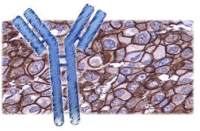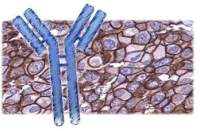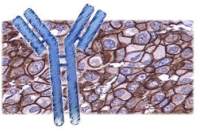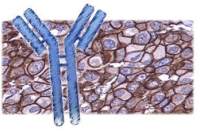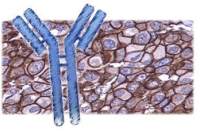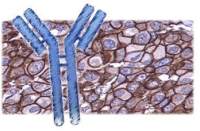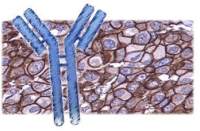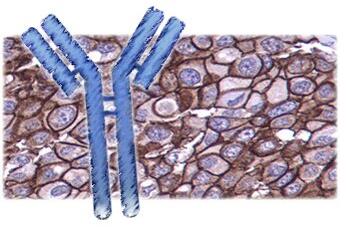
产品详情
文献和实验
相关推荐
供应商 :上海联迈生物工程有限公司
库存 :大量
靶点 :详见说明书
级别 :1
目录编号 :LM-11804R-FITC
克隆性 :多克隆
抗原来源 :Rabbit
保质期 :1年
抗体英文名 :Anti-ARFGEF2/FITC
抗体名 :Anti-ARFGEF2/FITC
标记物 :FITC标记
宿主 :Human, Mouse, Rat, Chicken, Dog, Pig, Cow, Horse, Sheep,
适应物种 :Human, Mouse, Rat, Chicken, Dog, Pig, Cow, Horse, Sheep,
免疫原 :详见说明书
亚型 :IGg
形态 :粉末、液体、冻干粉
应用范围 :ICC=1:50-200 IF=1:50-200
浓度 :1mg/ml
保存条件 :-20 °C
规格 :100ul
FITC标记的二磷酸腺苷核糖基化因子鸟嘌呤核苷酸交换因子2抗体| 英文名称 | Anti-ARFGEF2/FITC |
| 中文名称 | FITC标记的二磷酸腺苷核糖基化因子鸟嘌呤核苷酸交换因子2抗体 |
| 别 名 | ADP ribosylation factor guanine nucleotide exchange factor 2 (brefeldin A inhibited); ADP ribosylation factor guanine nucleotide exchange factor 2; ARFGEF 2; ARFGEF2; ARFGEP2; BIG 2; BIG2; Brefeldin A inhibited 2; Brefeldin A inhibited GEP 2; Brefeldin A inhibited guanine nucleotide exchange protein 2; dJ1164I10.1; BIG2_HUMAN. |
| 规格价格 | 100ul/2980元 购买 大包装/询价 |
| 说 明 书 | 100ul |
| 研究领域 | 细胞生物 神经生物学 信号转导 G蛋白信号 |
| 抗体来源 | Rabbit |
| 克隆类型 | Polyclonal |
| 交叉反应 | Human, Mouse, Rat, Chicken, Dog, Pig, Cow, Horse, Sheep, |
| 产品应用 | ICC=1:50-200 IF=1:50-200 not yet tested in other applications. optimal dilutions/concentrations should be determined by the end user. |
| 分 子 量 | 202kDa |
| 细胞定位 | 细胞膜 |
| 性 状 | Lyophilized or Liquid |
| 浓 度 | 1mg/ml |
| 免 疫 原 | KLH conjugated synthetic peptide derived from human ARFGEF2/BIG2 |
| 亚 型 | IgG |
| 纯化方法 | affinity purified by Protein A |
| 储 存 液 | 0.01M TBS(pH7.4) with 1% BSA, 0.03% Proclin300 and 50% Glycerol. |
| 保存条件 | Store at -20 °C for one year. Avoid repeated freeze/thaw cycles. The lyophilized antibody is stable at room temperature for at least one month and for greater than a year when kept at -20°C. When reconstituted in sterile pH 7.4 0.01M PBS or diluent of antibody the antibody is stable for at least two weeks at 2-4 °C. |
| 产品介绍 | background: Guanine nucleotide-exchange proteins (GEPs) accelerate replacement of bound GDP with GTP and thereby activate ADP-ribosylation factors (ARFs), a family of guanine nucleotide-binding proteins that play an important role in intracellular vesicular trafficking. GEPs comprise two major families, large GEPs that are inhibited by brefeldin A (BFA), a protein that effects golgi structure, and a group of smaller GEPs that are insenstive to BFA. Two genes for GEPs found on human chromosomes 8 and 20 encode BFA sensitive GEPs designated BIG1 and BIG2. Both GEPS contain a sec7 domain that is responsible for their brefeldin inhibition and also their catalytic activity. In vivo, BIG1 and BIG2 exist in macromolecular complexes that move between the golgi membranes and cytosol. BIG2 associates with PKA regulatory subunits, implying that BIG2 may act as an A kinase-anchoring protein (AKAP) that could coordinate the cAMP and ARF regulatory pathways. Function: ADP-ribosylation factors (ARFs) play an important role in intracellular vesicular trafficking. ARFGEF2 promotes guanine-nucleotide exchange on ARF1, ARF5 and ARF6 and the activation of ARF1/ARF5/ARF6 through replacement of GDP with GTP. It contains a Sec7 domain, which may be responsible for its guanine-nucleotide exchange activity and also brefeldin A inhibition. Subunit: Homodimer (Probable). Interacts with BIG1; both proteins are probably part of the same or very similar macromolecular complexes. Interacts with PRKAR1A, PRKAR2A, PRKAR1B, PRKAR2B, PPP1CC, PDE3A, TNFRSF1A, MYCBP and EXOC7. Interacts with GABRB1, GABRB2 and GABRB3 Subcellular Location: Cytoplasm. Membrane. Golgi apparatus. Cytoplasm, perinuclear region. Golgi apparatus, trans-Golgi network (By similarity). Endosome (By similarity). Cytoplasm, cytoskeleton, centrosome. Cell projection, dendrite (By similarity). Cytoplasmic vesicle (By similarity). Cell junction, synapse (By similarity). Cytoplasm, cytoskeleton (By similarity). Note=Translocates from cytoplasm to membranes upon cAMP treatment. Localized in recycling endosomes. Tissue Specificity: Expressed in placenta, lung, heart, brain, kidney and pancreas. Post-translational modifications: Phosphorylated upon DNA damage, probably by ATM or ATR. In vitro phosphorylated by PKA reducing its GEF activity and dephosphorylated by phosphatase PP1. DISEASE: Defects in ARFGEF2 are the cause of autosomal recessive periventricular nodular heterotopia type 2 (PVNH2) [MIM:608097]; also known as periventricular heterotopia with microcephaly autosomal recessive. PVNH is a developmental disorder characterized by the presence of periventricular nodules of cerebral gray matter, resulting from a failure of neurons to migrate normally from the lateral ventricular proliferative zone, where they are formed, to the cerebral cortex. PVNH2 is an autosomal recessive form characterized by microcephaly (small brain), severe developmental delay and recurrent infections. No anomalies extrinsic to the central nervous system, such as dysmorphic features or grossly abnormal endocrine or other conditions, are associated with PVNH2. Similarity: Contains 1 SEC7 domain. Database links: Entrez Gene: 10564 Human Entrez Gene: 99371 Mouse Entrez Gene: 296380 Rat Omim: 605371 Human SwissProt: Q9Y6D5 Human Important Note: This product as supplied is intended for research use only, not for use in human, therapeutic or diagnostic applications. |

上海联迈生物工程有限公司
品牌商实名认证
钻石会员
入驻年限:8年

